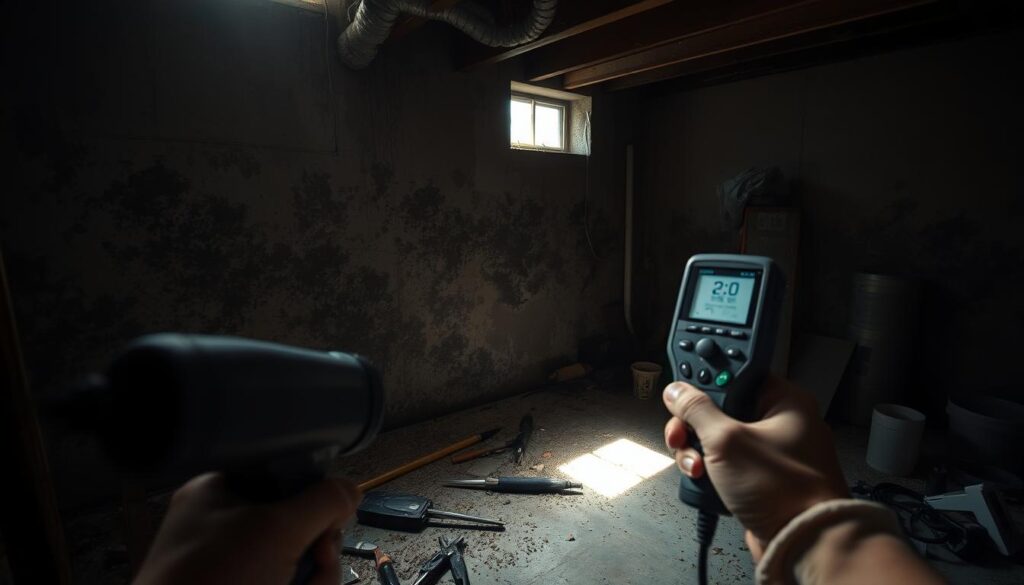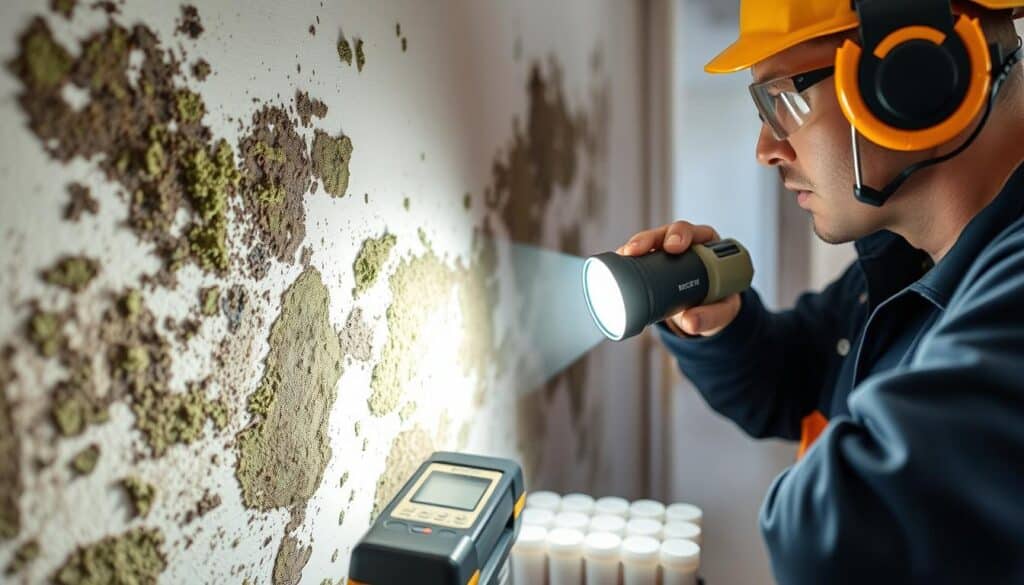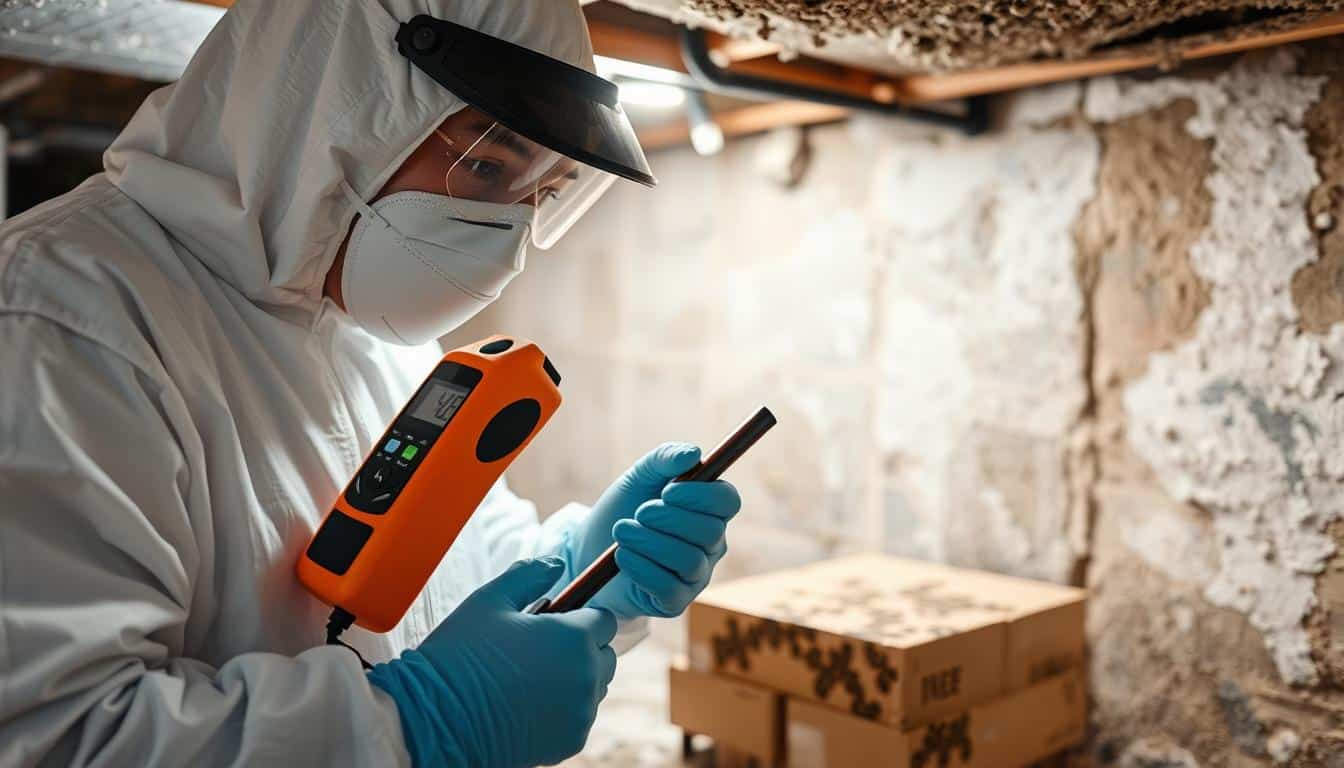Did you know mold can start growing on wet surfaces in just 48 hours? This fact shows how fast mold can spread and the health risks it brings. It’s important to understand the urgency of professional mold detection services.
Protecting our homes and health requires expert mold detection. Inspectors use advanced methods to find hidden mold. In Atlanta, mold remediation experts use top-notch equipment for thorough detection and removal.
Mold inspections usually last 2 to 5 hours, depending on the property’s size and complexity. During this time, experts do visual checks and may take samples for analysis. The cost for a mold inspection is around $200 to $350, a small price for peace of mind and health safety.
I’ve found that mold can spread quickly in homes, in as little as 72 hours. It’s crucial to act fast. Choose certified mold inspectors with at least 5 years of experience. They have the skills and tools to accurately assess mold and recommend the best course of action.
Key Takeaways
- Mold can start growing within 48 hours on wet surfaces
- Professional mold inspections typically take 2-5 hours
- The average cost of a mold inspection is $200-$350
- Mold can spread through a home in just 72 hours
- Choose certified mold inspectors with at least 5 years of experience
- Expert mold detection is crucial for protecting health and property
Understanding the Importance of Professional Mold Inspection
Professional mold inspection is key to keeping our homes healthy. We spend most of our time indoors, so it’s important to keep our spaces mold-free. Mold can grow fast, often in just a day or two, so finding it early is crucial.
Health Risks Associated with Mold Exposure
Mold can cause health problems, from allergies to breathing issues. Getting a mold test is important to find these risks. Experts can tell you how bad the mold is and how to fix it.
The Science Behind Mold Growth
Mold loves damp places with things to eat. Knowing how mold grows helps us stop it. Experts can find hidden moisture and mold spots.
Why DIY Mold Detection Isn’t Enough
DIY mold checks might seem cheap, but they miss a lot. Pros use special tools like infrared cameras to find mold in secret spots. They also test the air and surfaces for a full picture.
| Professional Inspection | DIY Methods |
|---|---|
| Comprehensive visual inspection | Limited visual check |
| Advanced technology (thermal imaging, endoscopic cameras) | Basic tools |
| Air and surface sampling | No scientific sampling |
| Detailed reports with recommendations | No professional guidance |
Choosing professional mold inspection means you get a thorough check and the right fixes. It keeps you and your home safe.
Key Scenarios That Warrant a Mold Inspection

I’ve seen many homes hit by mold. Some situations always make me think it’s time for a check. Buying a new home? That’s a great time for a mold test. Water damage from floods or leaks? You’ll want to look for mold. Restoring a vacant property? Mold thrives in damp, untouched places.
After mold removal, it’s key to make sure the job was done right. Even if you see mold, a pro can find more. The EPA says humidity over 60% can make mold grow, so checking moisture is important.
Here are key times to think about getting a mold check:
- Home purchases
- After water damage
- Restoring a vacant property
- After mold removal
- Seeing mold
- Noticing musty smells
- Experiencing health issues
Don’t just use DIY kits. Pros use special air sampling to find hidden mold. They can spot early signs like colored walls or window condensation. Remember, finding mold early stops big damage and keeps you healthy.
“Mold exposure can cause allergic reactions, asthma attacks, and respiratory infections. Early detection through mold testing enables quick action to prevent spreading and limit damage.
If you see these signs or find yourself in these situations, call the experts. A detailed mold check can save you from expensive fixes and health risks later.
The Comprehensive Mold Inspection Process
A thorough mold inspection is key to a healthy indoor space. It combines visual checks, advanced tech, and scientific sampling.
Visual Inspection Techniques
Inspectors first look for water damage, discoloration, and mold. This helps find problem spots and guides further checks.
Advanced Technology in Mold Detection
Modern tools help detect mold accurately. Infrared cameras find hidden moisture, a key for mold growth. These tools allow inspectors to spot issues without harming property.
Air and Surface Sampling Methods
Air sampling is vital for assessing environmental risks. Inspectors use special gear to collect air samples for mold spore analysis. Surface sampling involves swabs or tape lifts from suspect areas for lab tests.
| Sampling Method | Purpose | Cost Range |
|---|---|---|
| Air Sampling | Detect airborne spores | $75 – $100 per test |
| Surface Sampling | Identify visible mold | $75 – $100 per test |
| ERMI Sampling | Analyze settled spores | $200 – $300 per test |
These detailed methods ensure a complete check of your property’s mold situation. They offer crucial insights for any needed cleanup.
Mold Detection Services: What to Expect from Experts
When you hire professional mold detection services, you’re investing in your health and home. Expert mold inspectors offer a detailed approach to find and fix mold issues. They do thorough mold inspections, air quality checks, and help with remediation services.

During a mold inspection, experts use many methods to find mold. They look with their eyes, use moisture meters, and take air and surface samples. These tests show the type and amount of mold spores in your home.
Did you know mold is found in about 70% of homes in the U.S.? That’s why getting professional mold testing is key. Experts take samples from inside and outside your home to check your indoor air quality.
- Air sampling measures mold spores per cubic meter of air
- Surface sampling detects mold on various surfaces
- Bulk sampling examines materials for mold growth
After the inspection, you get a detailed report. It will tell you about the mold types, how much there is, and what to do next. With over 400,000 mold species, expert analysis is crucial for spotting harmful ones.
Remember, professional mold detection services protect you from health risks and damage from mold. Knowing what to expect helps you make smart choices for your home’s air quality and safety.
Benefits of Choosing Certified Mold Inspectors
Choosing a certified mold inspector can greatly improve the quality of your mold detection services. These experts have the knowledge and tools needed for accurate assessments. They ensure your results are thorough and reliable.
Qualifications and Certifications to Look For
When looking for mold detection services, it’s important to find inspectors with the right credentials. Look for certifications from organizations like the American Council for Accredited Certification (ACAC) or the National Environmental Health Association (NEHA). These certifications show the inspector has passed tough exams and knows a lot about microbial assessment.
The Advantage of Experience in Mold Detection
Experienced certified inspectors have a lot of knowledge to share. They use tools like moisture meters, infrared cameras, and air sampling devices to find hidden mold. Their skills help them give detailed reports on mold, its causes, and how to fix it.
Ensuring Unbiased Results and Recommendations
One big plus of hiring certified mold inspectors is their commitment to unbiased results. They focus only on inspecting and testing, without any conflicts of interest. This means you get science-based results and honest advice on how to deal with mold issues.
| Benefits | Certified Mold Inspector | Non-Certified Inspector |
|---|---|---|
| Advanced Tools | Yes | Limited |
| Specialized Training | Extensive | Minimal |
| Unbiased Results | Guaranteed | Not Guaranteed |
| Detailed Reporting | Comprehensive | Basic |
Advanced Tools and Technologies in Mold Detection
In my work as a mold remediation expert, I’ve noticed how new technology changes mold testing and moisture analysis. The Biomatrix Mold Monitor, priced at $39.99, is a big improvement. It has professional-grade sensors for detecting mold.
This device can save users a lot of money by reducing the need for expensive clean-ups. It also offers lifetime monitoring for free. Certified analysts keep an eye on property issues all the time.
I use many tools for detailed inspections. Hygrometers are key in mold testing, as they measure humidity. Mold grows best when humidity is 55% or higher.
Moisture meters are also important. They check wood and drywall for moisture. If wood moisture is over 20% or drywall is over 17%, it could mean mold is growing.
Air sampling is crucial for checking if mold removal was successful. Surface tests like bulk tests, swab tests, and tape lifts find mold on different surfaces. Borescopes are great for finding mold in hard-to-reach places.
| Tool | Function | Critical Level |
|---|---|---|
| Hygrometer | Measures humidity | 55% or higher |
| Moisture Meter (Wood) | Checks wood moisture | Above 20% |
| Moisture Meter (Drywall) | Checks drywall moisture | Above 17% |
Interpreting Mold Inspection Results
After a detailed mold detection service, I’m here to explain the results. It’s key to understand these findings to keep your air clean and plan for fixing mold.
Understanding Mold Types and Their Implications
Mold has many types, each affecting your health and home differently. Let’s look at some common ones:
- Penicillium/Aspergillus: Often found indoors, can trigger allergies
- Cladosporium: Common both indoors and outdoors
- Stachybotrys: Toxic mold that requires immediate removal
Assessing Contamination Levels
Mold spore levels show how bad the contamination is. Here’s a simple guide:
| Spore Count | Contamination Level | Action Needed |
|---|---|---|
| 0-500 | Very Low | No action required |
| 501-1500 | Low | Regular cleaning |
| 1501-3000 | Moderate | Potential remediation |
| 3001+ | High | Professional remediation required |
Developing a Remediation Plan
Based on the mold types and contamination levels, I’ll make a specific plan. This might include fixing moisture, removing affected materials, or using special cleaning methods. The aim is to make your air healthy again and stop mold from coming back.
The Role of Moisture in Mold Growth and Detection
Moisture analysis is key in mold inspection and environmental consulting. Mold grows well in damp places, needing humidity over 60% RH. As an expert, I’ve seen how moisture control is crucial in stopping mold. It’s not just about seeing water; hidden moisture in walls or under carpets can also cause mold.
During mold inspections, I use tools like the Tramex Moisture Encounter ME5 to find moisture without harming surfaces. This method is important to stop mold from growing in buildings. In places like bathrooms and kitchens, where moisture builds up, good ventilation is a must. It’s important to act fast when we find high moisture or humidity.
Environmental consulting often means finding where moisture problems come from. Most wall issues come from water getting in, often because of bad flashing. Different siding materials handle moisture differently – vinyl is easier to fix, while stucco and stone veneer are more likely to get damaged by moisture. By focusing on moisture analysis during mold inspections, we can find and fix problems before they get worse.
FAQ
What are the signs that I may need a mold inspection?
You might need a mold inspection if you see mold, smell musty odors, or have health issues. Also, if your home has had water damage or moisture problems.
Why is professional mold inspection important?
Mold inspectors are trained to find mold and use special tools. They give unbiased advice without any conflicts of interest. DIY methods often miss mold, which can harm your health and property.
When should I consider getting a mold inspection?
Get a mold inspection when buying a new home, after water damage, or restoring a vacant property. Also, if you see mold or after mold removal work.
What does a comprehensive mold inspection involve?
A detailed mold inspection includes a visual check and moisture detection with FLIR cameras. It also involves air and surface sampling and analyzing mold types and contamination levels.
What should I expect from a professional mold inspection service?
Expect a detailed inspection, clear explanations, and a report with findings and advice. Services may include mold testing, CIRS protocol testing, and more.
Why are certified mold inspectors important?
Certified inspectors know a lot about mold and how to inspect it. They give unbiased, science-based results to protect your health and property.
What advanced tools and technologies are used in mold detection?
Mold companies use standard sampling tools, FLIR cameras for moisture detection, and air and surface sampling. These tools help find problem areas and contamination levels.
How do I interpret the results of a mold inspection?
The report will tell you about the mold types, their health and property risks, and contamination levels. It will also suggest a plan to fix the problem.
Why is moisture an important factor in mold detection?
Moisture is key for mold growth, along with mold spores and food. Inspectors look for moisture to find mold, especially after water damage.




